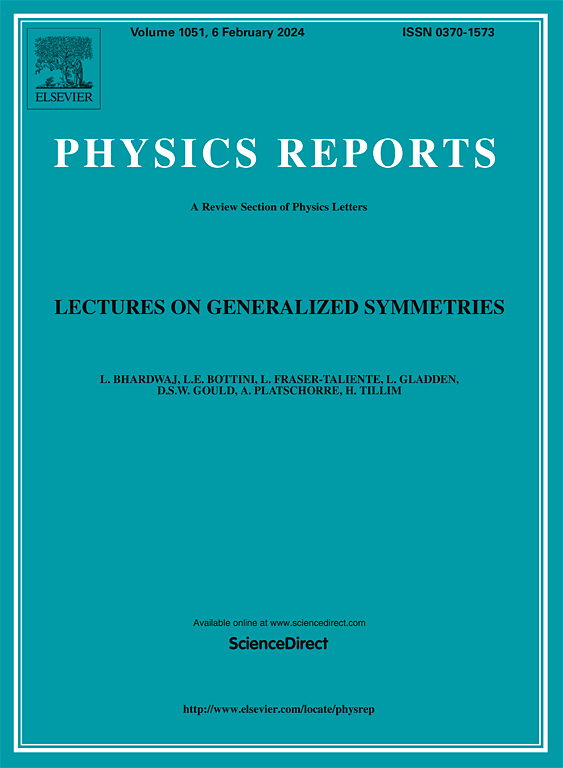The symmetry approach to quark and lepton masses and mixing
IF 29.5
1区 物理与天体物理
Q1 PHYSICS, MULTIDISCIPLINARY
引用次数: 0
Abstract
The Standard Model lacks an organizing principle to describe quark and lepton “flavours”. Neutrino oscillation experiments show that leptons mix very differently from quarks, adding a major challenge to the flavour puzzle. We briefly sketch the seesaw and the dark-matter-mediated “scotogenic” neutrino mass generation approaches. We discuss the limitations of popular neutrino mixing patterns and examine the possibility that they arise from symmetry, giving a bottom-up approach to residual flavour and CP symmetries. We show how such family and/or CP symmetries can yield novel, viable and predictive mixing patterns. Model-independent ways to predict lepton mixing and neutrino mass sum rules are reviewed. We also discuss UV-complete flavour theories in four and more space–time dimensions. As benchmark examples we present an scotogenic construction with trimaximal mixing pattern TM2 and another with flavour symmetry and generalized CP symmetry. Higher-dimensional flavour completions are also briefly discussed, such as 5-D warped flavordynamics with a symmetry yielding a TM1 mixing pattern, detectable neutrinoless double beta decay rates and a very good global fit of flavour observables. We also mention 6-D orbifolds as a way to fix the structure of the 4-D family symmetry. We give a scotogenic benchmark orbifold model predicting the “golden” quark–lepton mass relation, stringent neutrino oscillation parameter regions, and an excellent global flavour fit, including quark observables. Finally, we discuss promising recent progress in tackling the flavour issue through the use of modular symmetries.
夸克和轻子质量和混合的对称方法
标准模型缺乏一个组织原理来描述夸克和轻子的“味道”。中微子振荡实验表明,轻子与夸克的混合非常不同,这给味道之谜增加了一个重大挑战。我们简要概述了跷跷板和暗物质介导的“scotogenic”中微子质量产生方法。我们讨论了流行的中微子混合模式的局限性,并检查了它们产生于对称性的可能性,给出了一种自下而上的方法来研究残余味道和CP对称性。我们展示了这种家族和/或CP对称性如何产生新颖、可行和可预测的混合模式。回顾了与模型无关的预测轻子混合和中微子质量和规则的方法。我们还讨论了在四个或更多的时空维度上的紫外线完全风味理论。作为基准,我们提出了一个具有三极大混合模式TM2的A4型分型结构和一个具有S4味对称和广义CP对称的分型结构。本文还简要讨论了高维风味补全,例如具有T '对称的5维扭曲风味动力学,产生TM1混合模式,可检测的中微子双β衰变率以及非常好的风味观测值的全局拟合。我们还提到了6维轨道,作为一种固定4维族对称结构的方法。我们给出了一个预测“黄金”夸克-轻子质量关系的基准轨道模型,严格的中微子振荡参数区域,以及一个优秀的全局味拟合,包括夸克观测值。最后,我们讨论了通过使用模块化对称来解决风味问题的有希望的最新进展。
本文章由计算机程序翻译,如有差异,请以英文原文为准。
求助全文
约1分钟内获得全文
求助全文
来源期刊

Physics Reports
物理-物理:综合
CiteScore
56.10
自引率
0.70%
发文量
102
审稿时长
9.1 weeks
期刊介绍:
Physics Reports keeps the active physicist up-to-date on developments in a wide range of topics by publishing timely reviews which are more extensive than just literature surveys but normally less than a full monograph. Each report deals with one specific subject and is generally published in a separate volume. These reviews are specialist in nature but contain enough introductory material to make the main points intelligible to a non-specialist. The reader will not only be able to distinguish important developments and trends in physics but will also find a sufficient number of references to the original literature.
 求助内容:
求助内容: 应助结果提醒方式:
应助结果提醒方式:


